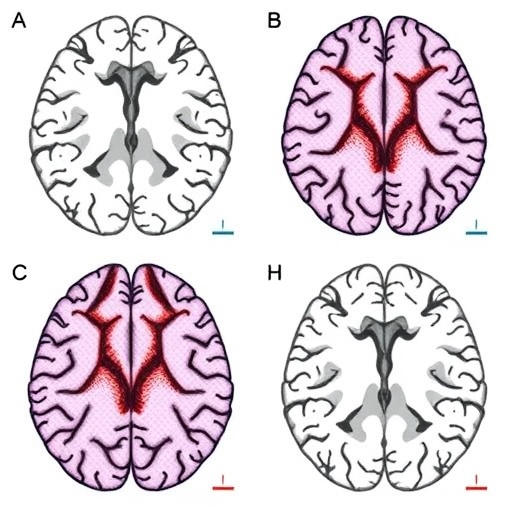Recent advances in neuroimaging and neuropathology have begun to unravel the intricate complexities underlying neurodegenerative diseases, notably dementia with Lewy bodies (DLB). A groundbreaking study led by Mak, Reid, Przybelski, and colleagues, published in npj Parkinson’s Disease in 2025, sheds light on the cortical microstructural abnormalities characterizing DLB and critically explores their intricate associations with Alzheimer’s disease (AD) copathologies. These revelations not only deepen scientific understanding of DLB’s multifaceted nature but may also pave the way for precision diagnostics and targeted therapeutic interventions in the future.
Dementia with Lewy bodies is recognized as one of the leading causes of dementia, second only to Alzheimer’s disease, and is clinically defined by a complex constellation of cognitive, motor, and neuropsychiatric symptoms. Despite sharing overlapping phenomenology with AD, DLB’s pathological substrates diverge, being primarily characterized by the aggregation of alpha-synuclein protein into Lewy bodies within cortical and subcortical neurons. However, recent neuropathological evidence has increasingly demonstrated that DLB frequently coexists with hallmark AD pathologies such as beta-amyloid plaques and tau neurofibrillary tangles, complicating diagnosis, prognosis, and understanding of disease mechanisms.
In this comprehensive investigation, the research team employed advanced neuroimaging techniques, including diffusion tensor imaging (DTI) and neurite orientation dispersion and density imaging (NODDI), to meticulously analyze microstructural features of cortical gray matter in individuals diagnosed with DLB. These cutting-edge MRI modalities permit in vivo characterization of neuronal architecture, synaptic density, and axonal integrity at a resolution previously unattainable, enabling researchers to detect subtle microstructural alterations that traditional imaging fails to capture.
What emerged from this detailed neuroimaging analysis was a distinct pattern of cortical microstructural abnormalities in DLB patients relative to healthy controls and AD patients. Specifically, the team observed significant reductions in neurite density and increased neurite orientation dispersion in multiple cortical regions implicated in cognition and sensorimotor integration. These abnormalities are indicative of dendritic pruning, synaptic loss, and disrupted local connectivity which underlie the profound cognitive and motor impairments characteristic of DLB.
Moreover, the study meticulously dissected how these microstructural changes relate to the presence and burden of concomitant AD pathologies. Using cerebrospinal fluid biomarkers and postmortem histological confirmation where available, they established that greater AD-related copathology burden — including amyloid and tau depositions — exacerbated cortical microstructural disruptions in DLB patients. These findings underscore the synergistic and possibly accelerating effects of mixed neuropathologies on cortical integrity, suggesting that DLB is not a standalone pathology but often a complex interplay of synucleinopathy and Alzheimer-type changes.
From a mechanistic perspective, the paper postulates that the interplay between alpha-synuclein aggregation and AD-related amyloid and tau pathologies may impair neuronal homeostasis, trafficking, and synaptic plasticity more severely than either pathology alone. The additive effect likely disrupts cortical microcircuits and connectivity gradients essential for cognitive and motor functions, accounting for the atypical clinical and radiological phenotypes observed in many DLB patients.
Importantly, the authors highlight the clinical relevance of these microstructural changes. Unlike gross atrophy measured by volumetric MRI, microstructural MRI abnormalities reflect early and potentially reversible neurobiological alterations preceding overt neuronal loss. This suggests potential windows for intervention and provides neuroimaging biomarkers that could facilitate early diagnosis, monitor disease progression, and evaluate treatment efficacy in clinical trials targeting either alpha-synuclein or amyloid-tau pathologies.
Furthermore, the study discusses the implications of their findings for differential diagnosis between DLB and AD. Given the overlapping clinical symptoms and co-occurrence of pathological hallmarks, distinguishing pure DLB from AD or mixed pathology cases remains challenging. Microstructural imaging signatures described in this work could enhance diagnostic specificity by revealing unique patterns of neurite alteration characteristic of Lewy body pathology versus Alzheimer’s, thus aiding clinicians in tailoring management strategies more accurately.
The methodological rigor and multidisciplinary approach in this research are particularly noteworthy. Integrating advanced neuroimaging, biomarker analyses, and neuropathological validation strengthens the causative inferences drawn and sets a new precedent for future investigations into neurodegenerative disease mechanisms. Additionally, the study’s large cohort and inclusion of well-characterized clinical and pathological data add robustness to its conclusions and enhance the generalizability of its findings.
Looking ahead, the authors advocate for longitudinal studies to track how cortical microstructural abnormalities evolve over time in relation to cognitive decline, clinical symptomatology, and therapeutic interventions. Moreover, extending investigations into younger or prodromal populations could reveal early biomarkers predictive of disease conversion and progression, offering critical insights into disease prevention and modification strategies.
The integration of multi-modal neuroimaging biomarkers with molecular and genetic data, as exemplified in this study, marks a paradigm shift towards precision neurology. By elucidating disease-specific microstructural signatures and their pathological underpinnings, researchers are moving closer to unraveling the complex biological heterogeneity of dementia syndromes, including DLB. Such efforts are vital for the development of personalized medicine approaches aimed at optimizing outcomes for patients suffering from these debilitating disorders.
In conclusion, the 2025 study spearheaded by Mak and colleagues represents a landmark accomplishment in delineating the cortical microstructural landscape of dementia with Lewy bodies and its interplay with Alzheimer’s disease pathologies. The discovery of distinct neuritic alterations offers novel insights into DLB pathophysiology and highlights the necessity of considering coexisting AD pathology when evaluating patients clinically and in research settings. These findings have far-reaching implications for diagnosis, prognosis, and the future design of targeted therapeutics.
As neuroimaging technology and molecular neuropathology continue to evolve, the integration of these disciplines promises to unlock further secrets of the brain’s microarchitecture in health and disease. The revelations from this pivotal study underscore the intricacy of neurodegenerative diseases and propel the field toward a more nuanced and effective approach to understanding and combating dementia.
Subject of Research: Cortical microstructural abnormalities in dementia with Lewy bodies and their associations with Alzheimer’s disease copathologies
Article Title: Cortical microstructural abnormalities in dementia with Lewy bodies and their associations with Alzheimer’s disease copathologies
Article References:
Mak, E., Reid, R.I., Przybelski, S.A. et al. Cortical microstructural abnormalities in dementia with Lewy bodies and their associations with Alzheimer’s disease copathologies.
npj Parkinsons Dis. 11, 124 (2025). https://doi.org/10.1038/s41531-025-00944-x
Image Credits: AI Generated




